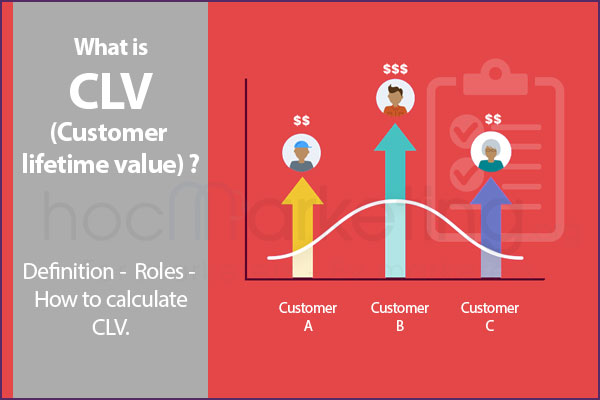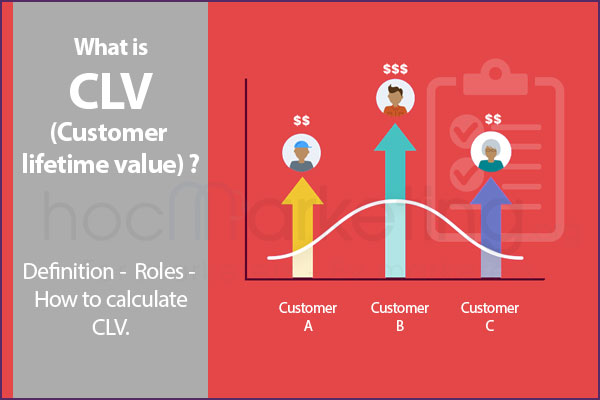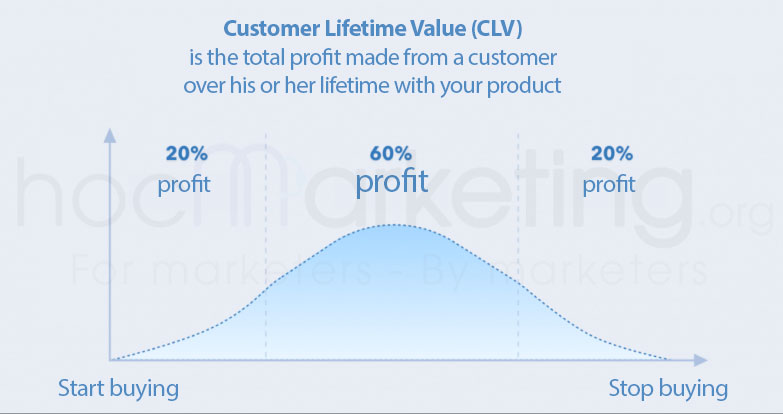
What is Customer lifetime value (CLV)? How to calculate CLV

Customer lifetime value is a key metric for any business and should be considered when strategizing marketing campaigns. In this blog post you will learn what Customer Lifetime Value (CLV) is, and how CLV is calculated.
Customer lifetime value is a key metric for any business and should be considered when strategizing marketing campaigns. Understanding customer lifetime value helps to optimize the company's strategy to increase profits, revenue, and market share. In this blog post you will learn what Customer Lifetime Value (CLV) is, and how CLV is calculated.
What is Customer lifetime value (CLV)?
Customer lifetime value (CLV) is the total profit made from a customer over his or her lifetime with your product. CLV can be used to calculate how much to spend on acquiring new customers and also calculating the costs of customer acquisition to determine whether or not an acquisition strategy yields a positive return on investment.
Short history of Customer lifetime value (CLV)
The CLV concept was first introduced by Frederick Reichheld and W. Earl Sasser, Jr. in their 1990 Harvard Business Review article entitled "Zero Defections: Quality Comes to Services." The authors were the first to observe that a small percentage of customers are responsible for a disproportionately large share of profits in service industries.
Nowadays, CLV is used in various industries, for example to assess the value of an email list. In special cases where there is a high risk that customers will not spend money with the company again, CLV can be negative.
Why is Customer Lifetime Value Important?
1. CLV helps businesses identify ideal customers, thereby maximizing profits.
CLV reflects the customer's return to the business. The higher the CLV, the more profitable the business. By comparing the CLV of each customer segment, businesses can easily identify the ideal segment, thereby focusing efforts to maintain and develop the most profitable segment for the business.
2. CLV helps businesses optimize marketing activities.
Determining the CLV of each customer will also help businesses come up with appropriate marketing strategies for each of those objects. Usually, for customers with high CLV, businesses need to maintain customer care activities, as well as provide additional value for each purchase to retain them longer. For customers with low CLV, businesses need to have appropriate promotions and stimulus programs to encourage them to return in the near future.
3. CLV helps businesses improve customer loyalty.
CLV itself is the result of 2 variables: Profit earned per purchase x customer lifetime. Thus, to improve CLV, enterprises need to increase 1 of 2 (or both of the above variables). However, in most cases, businesses will choose variable 2 - customer life cycle - because purchases often bring higher profits and promote more sustainable business development. Therefore, extending the customer's lifecycle helps to increase customer loyalty to that business.
How to calculate Customer lifetime value (CLV)
1. Calculate the Average Purchase Value (APV)
Average Purchase Value (APV) is the average profit that the business earn from each order.
APV can be defined by using this formula:
APV = (Total revenue - Total expense)/Number of orders
Example: In October 2021, store A records 250 orders, bringing in total revenue of $1,200 and total costs of $800. Thus, the average purchase value of store A in October 2021:
APV10/2021 = (1200 - 800) / 250 = 1.6 USD.
Thus, for each sale order, store A earns an average of 1.6 USD in temporary profit.
2. Calculate the Average Purchase Frequency Rate (APFR)
Average Purchase Frequency Rate is the average number of transactions a customer makes with your company.
APFR can be defined by using this formula:
APFR = (Number of orders / Number of years)
For example, Store B records the APFR index in 2020 as follows:
| Tháng | Tổng số đơn hàng | Tổng số khách hàng | APFR |
| 1/2020 | 5842 | 955 | 6.12 |
| 2/2020 | 3202 | 704 | 4.55 |
| 3/2020 | 4577 | 992 | 4.61 |
| 4/2020 | 5821 | 1021 | 5.70 |
| 5/2020 | 6874 | 1187 | 5.79 |
| 6/2020 | 4109 | 945 | 4.35 |
| 7/2020 | 6879 | 1402 | 4.91 |
| 8/2020 | 4284 | 1038 | 4.13 |
| 9/2020 | 7025 | 1312 | 5.35 |
| 10/2020 | 5378 | 1289 | 4.17 |
| 112020 | 7581 | 1208 | 6.28 |
| 12/2020 | 6825 | 1136 | 6.01 |
| Năm 2020 | 68397 | 13187 | 5.19 |
Thus, in 2020, an average of 1 customer places 5.19 orders at store B.
3. Calculate the Customer Value (CV)
Customer Value is a customer's estimated net profit to a company within a regular time (day, month, year...)
CV can be defined by using this formula:
CV = APV x APFR
For example: In the first 6 months of 2021, restaurant C recorded an average value per customer (APV) of USD 220, an average purchase frequency (APFR) of 3.2 → Average customer value (CV) = 220 x 3.2 = 704 USD.
Thus, in the first 6 months of 2021, on average, 1 customer brings restaurant C approximately 704 USD in estimated profit every month.
4. Calculate the Average Customer Lifespan (ACL)
Average Customer Lifespan is the average length of time a person remains as a customer.
ACL can be defined by using this formula:
ACL = (Sum of customer lifespan)/(Total number of customers)
For example, Enterprise D records the total continuous purchase time of 10897 customers from 2018 - 2020 as 5897204 days → Average lifecycle of each customer (ALC) = 5897204 / 10897 = 541 days (18 months or 1.4 years).
5. Calculate Customer Lifetime Value (CLV)
Finally, Customer Lifetime Value (CLV) can be defined by using the fomula:
CLV = CV * ACL
Example: After the above calculation steps, enterprise E records.
- CV (Average Customer Value) = 110 USD/month
- ACL (Average Customer Lifecycle) = 18 months
=> CLV (Average Customer Lifetime Value) of enterprise E = 110 x 18 = 1980 USD.
Thus, during the operation of business E, on average, each customer will bring to the enterprise 1980 USD in estimated profit.
Short formula
By replacing CV and ACL with more basic variables, we have the formula to calculate CLV quickly with a single step as follows:
Summary
Understanding Customer Lifetime Value (CLV) is crucial for any business. If you can calculate the CLV of your customers, it will help to determine how much a customer is worth to your company and which strategies are best suited for their needs. Armed with this knowledge, you’ll be able to make informed decisions about whether or not it's worthwhile investing in acquiring new customers and what methods may work best for retaining current ones - even if they're already loyal!












